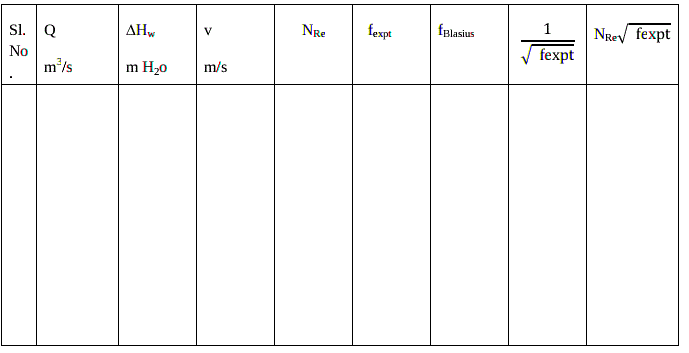Flow Through Pipes
Apparatus required :
CCL4 manometer, Hg manometer.
Procedure :
- Keep the valve leading to the smooth pipe open and valves leading to other lines closed.
- Keep the bypass valve completely open and the main valve completely closed. Switch on the pump.
- Connect a CCL4 manometer, to the pressure taps across the smooth pipe. Ensure that no air bubbles present and height in both the limbs of manometer are the same.
- Set a flow rate of water through the pipe by opening the main valve and throttling the bypass valve suitably using the rotameter.
- Note down the rotameter reading and manometer reading after a steady state is attained.
- Increase the flow rate of water by opening the main valve and throttling the bypass valve suitably and repeat step 4 and 5.
- Use mercury manometer for higher flow rates.
- Take eight readings with CCL4 manometer as well as with Hg manometer.
Data :
Diameter of the pipe= D =
m
Length of the pipe= L = m
Density of water =.gif) = kg/m3
= kg/m3
Viscosity of water = .gif) =cp= kg/ms
=cp= kg/ms
Density of CCl4 = 1600 kg/m3
Density of Hg = 13600 kg/m3
Observations :
| Sl No. |
Rotameter reading LPM |
Manometer reading |
|---|---|---|
| Hm cm |
||
Calculations :
- ∆Hm is cm of manometric fluid
- Volumetric flow rate, Q = m3/s
- Pressure drop in m of water
.gif)
- Cross sectional area of the pipe A =
.gif)
- Average velocity through the pipe = V=Q/A = m/s
- Reynolds number = NRe =
.gif) =
= - Friction factor f is calculated using f Blasius equation:
.gif)
- Friction factor
.gif)
- Nicurdse’s correlation:
.gif)

Plot fexpt vs NRe on log-log graph. Compare them.
To verify Nicurdse’s correlation:
.gif)
.gif) on a semi log graph :
on a semi log graph :
- Find the slope and intercept.
- Compare with Nicurdse ’s correlation.
- Discuss on effect of Reynolds number on friction factor.
